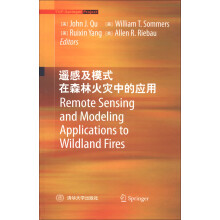1 Introduction to remote sensing and modeling applications to wildland fires
References
2 Wildland fire and eastern states diversity
2.1 Introduction
2.2 The eastern united states
2.3 Eastern united states diversity
2.4 A fire information strategy for the eastern states
R eferences
3 Demographic trends in the eastern us and the wildland urban interface: implications for fire management
3.1 Introduction
3.2 Demographics
3.3 The wildland urban interface
3.3.1 Georgia case study
3.4 Iimplications for managers
3.5 Conclusion
Acknowledgements
References
4 An overview of noaa's fire weather, climate, and air qualityforecast services
4.1 Nws fire weather
4.2 Products and services
4.3 Making optimal use of nws technology
4.3.1 Digital services
4.4 MNws climate services
4.4.1 Product improvements
4.5 National air quality forecasting
4.5.1 Planned capabilities
4.6 Summary
References
5 A Review of wildland fire and air quality management
5.1 Introduction
5.1.1 Smoke contributes to air pollution
5.2 Regulatory considerations relating to smoke
5.2.1 Regional haze rule
5.2.2 National ambient air quality standards for pm
5.2.3 Managing smoke from wildfire
5.3 A Review of the taset report——tools available to manage smoke
5.4 Smoke management——programs and systems
5.4.1 Plan
5.4.2 Do (implement)
5.4.3 Check (evaluate)
5.4.4 Act (improve)
5.5 Aummary
Acknowledgements
References
6 High-resolution numerical models for smoke transport in plumes from wildland fires
6.1 Introduction
6.2 Numerical model
6.3 Dynamical properties of simulated plumes
6.3.1 Mean plume trajectories
6.3.2 Mean plume structure
6.3.3 Turbulent kinetic energy (tke)
6.4 Summary and conclusions
Acknowledgements
References
7 Interaction between a wildfire and the sea-breeze front
7.1 Introduction
7.1.1 Sea-breeze structure and characteristics
7.1.2 Radar observations of smoke plumes and the sea-breeze
7.1.3 Effect of sea-breezes on fires
7.1.4 East fork fire
7.2 Data and methodology
7.2.1 Case study
7.2.2 Idealized numerical simulations
7.3 Case study analysis
7.4 Numerical simulations
7.5 Summary and conclusions
Acknowledgments
References
8 Prescribed fire and air quality in the american south: a review of conflicting interests and a technique for incorporating the land manager into regional air quality modeling
9 Estimates of wildland fire emissions
10 Integrating remote sensing and surface weather data to monitor vegetation phenology
11 Creating a crosswalk of vegetation types and fire fuel models for the national park service
12 Diurnal and seasonal cycles of land fires from trmm
13 Fire research in the new jersey pine barrens
14 Dead fuel loads in north carolina's piedmont and coastal plain and a small scale assessment of nfdrs fuel models
15 Numerical simulations of grassland fire behavior from the lanl-firetec and nist-wfds models
16 Physics-based modeling of wildland-urban interface fires
17 Climate change and fire impacts on ecosystem critical nitrogen load
18 Simulating fire spread with landscape level edge fuel scenarios
19 The need for data integration to achieve forest sustainability: modeling and assessing the impacts of wildland fire on eastern landscapes
20 Automated wildfire detection through artificial neural networks.
21 Altered disturbance regimes: the demise of fire in the eastern united
22 Fire spread regulated by weather, landscape structure, and management in
23 The gofc-gold fire mapping and monitoring theme:Assessment and strategic plans

 缺书网
缺书网 扫码进群
扫码进群





